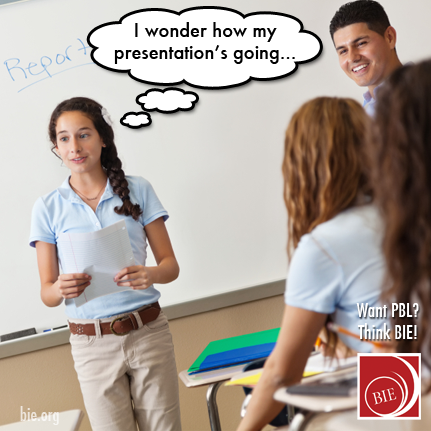This excerpt appears in the Buck Institute for Education's book, "PBL for 21st Century Success: Teaching Critical Thinking, Collaboration, Communication, Creativity." Rubrics for each of the "4 C's" are in the book, and we offer guidance below on how to use them in a PBL context. They are also available to download on BIE's website at the following links:
- Upper Elementary School Presentation Rubric
- Middle School Presentation Rubric
- High School Presentation Rubric
What these rubrics assess
These rubrics describe what good critical thinking, collaboration, communication, and creativity & innovation look like in the context of Project Based Learning. The rubrics do not describe these competencies as they are seen generally or in other settings. For example, the Common Core State Standards for English/Language Arts call upon students to think critically when reading literature by making inferences and determining the author’s intent. But since the particular content of projects will vary, the Critical Thinking Rubric for PBL only describes aspects of critical thinking that apply to tasks found in all projects, such as evaluating the reliability of a source of information. The same is true for communication; instead of describing competency in all types of communication, such as writing or listening to a speaker, we have chosen to focus the rubric on making a presentation, a competency common to all projects.

What these rubrics do NOT assess: “content”
These rubrics are designed to assess only the 4 C’s, not subject-area knowledge in, say, math, history, or science. This content should be assessed with a separate rubric—or by adding rows to these rubrics. A “content + 4 C’s” rubric can be created by the teacher for the particular product in the project, and target particular content standards. For example, the Presentation Rubric for PBL includes criteria for how well a student organizes ideas, speaks, and uses presentation aids. However, the rubric does not mention specific terminology, concepts, or subject-area information that should be used in the presentation, as determined by the teacher. The same goes for critical thinking; the rubric does not assess subject area knowledge when teams in a biology class decide if the government should fund gene therapy research or teams in an English class investigate the relevance of Macbeth to modern society. In other words, the rubric is designed to assess critical thinking skills used in projects anchored in subject-area content, but that content should be assessed separately.
How these rubrics align with Common Core State Standards
Competency in critical thinking, collaboration, communication, and creativity is required to meet many of the Common Core State Standards (CCSS) in English Language Arts and Literacy for History/Social Studies, Science, and Technical Subjects. he 4 C's are reflected in the "Mathematical Practices" section of CCSS, but not in the specific numbered standards, so they are not cited.
In these rubrics, note that:
- Specific ELA standards are cited in the “At Standard” column only, but their intent is reflected in the “Approaching” and “Below” columns too.
- Exact CCSS language is used when possible—which could be useful as a vocabulary-building opportunity for students—but occasionally we used more student-friendly terms.
- The CCSS does not specifically address all of the 21st century competencies used in PBL, so some items appear on the rubrics without “CC” citations.
How to use these rubrics
The primary purpose of these rubrics is to help students reflect on their work and understand more clearly what they need to do to improve. Consider these tips for using the rubrics:
- Teachers may use the rubric as a source of guiding ideas for creating their own rubric, or choose not to use certain rows, or adapt the language to fit the needs of their students and the design of the project.
- Teachers should help students understand the rubric; give examples, explain new vocabulary words, put the language in their own words, and so on. Show models of the performance and have students practice using the rubric to assess them.
- Give students the rubric near the beginning of a project. Have them assess themselves and reflect on their progress at checkpoints and at the end.
- A student’s performance may be described by some items in one column and some in another.
How to find evidence of 21st century competencies
Sources of evidence for 21st century competencies may include journals or other writing in which students document their use of the competency, self- and peer-reflections, and teacher observations. Another source of evidence is the product students create and/or their explanation of how it was created. For example, when students share project work with an audience a teacher can, in addition to assessing their competency in making a presentation, ask them to explain how they used critical thinking or followed the process of innovation.
How these rubrics are organized
Two of the rubrics, Critical Thinking and the “Process” section of Creativity & Innovation, are organized by the four phases of a typical project. This is because different aspects of these competencies come into play at different times. The other two rubrics, for Collaboration and Presentation, do not follow the phases of a project. The Presentation Rubric is only used in the last phase of a project, when students share their work with a public audience. However, competency in collaboration is relevant to all phases of a project. For example, a student should complete tasks on time, build on others’ ideas, and show respect for teammates not just at the beginning of the project, but throughout it.
The columns along the top describe levels of quality:
- Below Standard: What students do when they have not yet shown evidence of the competency.
- Approaching Standard: What students do when they are showing some evidence of gaining the competency, but still have gaps or deficiencies.
- At Standard: What students do when they show evidence of having gained the competency to an appropriate degree for their age and experience.
- Above Standard: What students do when they go beyond what is expected to demonstrate competency. This column is left blank, with space for making a check mark. See the notes below on how to use this column.
How to use the “Above Standard” column
It’s hard to predict or describe what a student may do when performing “Above Standard” but it’s often the case that “you’ll know it when you see it.” For this reason, we’ve left this column blank. A teacher could wait until it happens, then describe it. For example, an advanced critical thinker might make an especially insightful analysis of a text or source of information. A student with advanced competency in collaboration might show leadership that brings out the talents and efforts of others on a team. A highly skilled presenter might use humor, emotion, stories, metaphors, or interactive features “like a pro.” A creative product might have a “wow factor” or be similar to what an adult professional might create.
A teacher could also involve students in co-constructing language for the “Above Standard” column. Have them analyze samples of work from previous projects or professional products, then describe what makes them “go beyond expectations.”
How to assign scores or grades
These rubrics do not feature a numerical scale—we leave it up to the teacher who uses them to decide how to assign scores or grades. Some dimensions may be given more or less weight. For example, on the Collaboration Rubric, “Helps the Team” might count for more than “Respects Others,” depending on a teacher’s goals.
Within each of the levels of quality described by the rubric, there could be variation, so a teacher may want to allow for a range of scores or points in each. For example, a very weak “Below Standard” performance could be scored a “1” and a “2” could indicate a somewhat weak performance. Similarly, a very advanced or “Above Standard” performance could be scored as a “6” with a “5” being “At Standard.”
Feel free to draw language from the rubrics to create your own scoring guides for use with students, teachers, adult mentors, or presentation audience members.
This short research brief summarizes evidence of the impact of Project Based Learning on student learning in core content areas. The driving question for this brief is based on the most common question that teachers, principals, school leaders, coaches, and grant writers ask us at the PBLWorks about Project Based Learning (PBL): What evidence exists that shows the impact of Project Based Learning on student learning in core content areas.
Citation: Kingston, S. (2018). Project Based Learning & Student Achievement: What Does the Research Tell Us? PBL Evidence Matters. 1(1), 1-11.
Source Organization: PBLWorks

